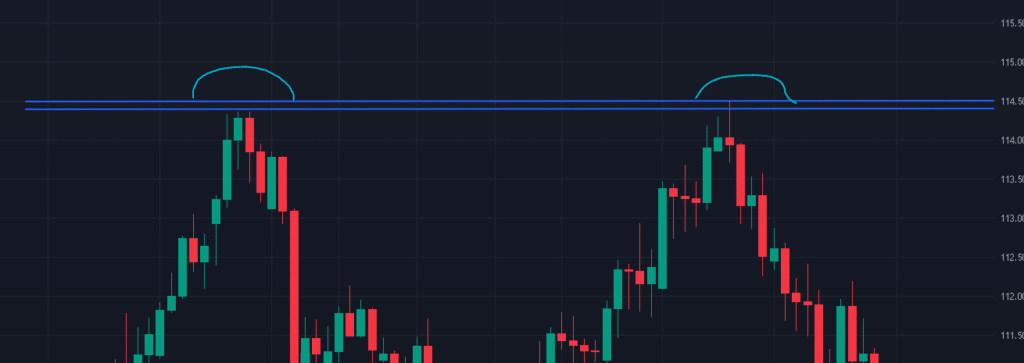In the dynamic world of Forex trading, patterns play a crucial role in identifying potential price reversals. One such pattern that traders often encounter is the double top. Understanding how to trade the double top pattern can provide you with a strategic advantage in your trading endeavours.

What is the Double Top Pattern?
Imagine looking at a price chart and spotting two peaks that resemble the letter “M.” This is the essence of the double top pattern. It’s a technical analysis formation that signals a potential reversal from an uptrend to a downtrend. The pattern forms when an asset’s price hits a resistance level twice, fails to break through, and eventually retraces.
Picture the first peak as the market reaching a high point, followed by a temporary decline—a retracement. Then, the market rallies again, attempting to surpass the previous high. However, it encounters the same resistance, resulting in the formation of the second peak, at a similar level to the first. The trough that forms between the two peaks is the support level.
Identifying the Pattern
Spotting a double top pattern involves more than just recognizing two peaks. Here’s how you can identify this pattern:
Peak Levels: Both peaks should be relatively close in height and occur around the same price level.
Trough: The trough between the peaks is the support level. It’s essential that the price doesn’t drop significantly below this trough.
Confirmation: The pattern is confirmed when the price breaks below the support level (the trough) after the second peak, signaling a potential downtrend.
Trading Strategies for Double Tops
Trading the double top pattern requires careful analysis and strategy. Here’s a step-by-step guide:
Pattern Recognition: Identify the double top pattern on a price chart. Look for two distinct peaks with a trough between them.
Confirmation: Wait for the price to break below the trough. This confirms the pattern and indicates a potential trend reversal.
Entry Point: Enter a short position (selling) when the price breaks below the trough. This could be accompanied by an increase in volume, strengthening the signal.
Stop-Loss and Take-Profit: Set a stop-loss slightly above the second peak to limit potential losses. Determine a take-profit level based on the projected downward movement.
Risk Management: Calculate your position size based on your risk tolerance and overall trading capital.
Monitoring: Keep a close eye on the trade as it develops. The price should ideally move in the anticipated direction.
Market Context and Analysis
Consider the broader market context before trading a double top pattern. Are there other technical indicators or fundamental factors supporting a potential reversal? Is the pattern forming at a significant resistance level? These factors can enhance the reliability of your trade.
Remember, not all double tops lead to successful trades. Like any trading strategy, the double top pattern is a tool to assist decision-making, but it’s not foolproof. Risk management and careful analysis remain essential components of successful trading.
In conclusion, the double top pattern is a valuable tool in a trader’s arsenal. It indicates potential trend reversals and offers trading opportunities when combined with proper analysis and risk management. By understanding the pattern’s structure and applying it within the context of the broader market, you can increase your odds of making informed trading decisions in the ever-evolving world of Forex.
How to Identify the Double Top Pattern?
Recognizing the double top pattern amidst the complexities of Forex charts requires keen observation. Here’s a comprehensive guide on identifying this pattern:
Peaks: Look for two prominent peaks that are approximately at the same price level. These peaks resemble the letter “M.”
Trough: Between the two peaks, there should be a noticeable trough or dip. This trough signifies a temporary pullback before the second peak.
Resistance Level: The tops of the peaks touch or approach a common resistance level. This level acts as a barrier preventing further upward movement.
Volume Analysis: Monitor trading volume during the formation of the pattern. Volume tends to diminish between the peaks and may surge when the price breaks below the trough.
What does the Double Top Pattern Indicate? Bearish or time to short?
The double top pattern carries significant implications for traders, signaling a potential shift in market sentiment. Here’s what it indicates and how to capitalize on it:
Bearish Reversal: The double top pattern is a bearish reversal pattern. It suggests that an uptrend is losing steam, and buyers are struggling to push prices higher. The pattern’s confirmation occurs when the price breaks below the trough, indicating a shift from bullish to bearish sentiment.
Time to Short: When the double top pattern confirms, it’s an opportune moment for traders to consider short positions. Selling at the break of the trough can lead to potential profits as prices are anticipated to decline further.
Target Projection: The projected downward movement after the pattern’s confirmation can be estimated by measuring the distance between the trough and the pattern’s peak, then subtracting it from the breakout point.
Risk Management: As with any trade, managing risk is paramount. Set a stop-loss slightly above the second peak to mitigate potential losses if the pattern fails to materialize.
Confirmation: Confirmation of the pattern occurs with a decisive break below the trough. This validates the bearish reversal and signals an entry point for short positions.
Market Context: Consider the broader market context and additional technical indicators. Confirmatory factors like overbought conditions or divergence can bolster your decision to go short.
In essence, the double top pattern is a potent tool for traders seeking bearish opportunities. Its structure and confirmation signals provide valuable insights into potential trend reversals. By accurately identifying the pattern and understanding its bearish implications, traders can make informed decisions to profit from impending price declines in the dynamic Forex market.
Reliability of the Double Top Pattern?
While the double top pattern is a valuable tool for identifying potential trend reversals, its reliability depends on several factors. Here’s an in-depth exploration of its reliability and considerations for traders:
Market Context: The reliability of the pattern is influenced by the broader market context. A double top pattern forming at a significant resistance level or after a prolonged uptrend tends to be more reliable.
Volume Confirmation: Higher trading volume during the pattern’s formation and confirmation adds to its reliability. Volume indicates the strength of market sentiment.
Pattern Symmetry: Well-defined symmetry between the two peaks and the trough enhances reliability. Clear peak heights and a distinct trough indicate a more reliable pattern.
Confirmation Break: The pattern’s reliability increases when the price decisively breaks below the trough. A strong breakout validates the bearish sentiment.
Confirmation Time: Patterns that confirm relatively quickly after the second peak tend to be more reliable than those that take an extended period.
Backtesting: Analyzing historical data to identify how often the pattern leads to successful trades can provide insights into its reliability within specific markets.
Risk Management: Regardless of reliability, effective risk management is essential. Always use stop-loss orders and manage position sizes to control potential losses.
What time frames are Double Top Patterns most reliable?
The reliability of the double top pattern can vary across different time frames. Here’s a breakdown of its reliability across common time frames:
Shorter Time Frames (Intraday): Double top patterns on shorter time frames (e.g., 5-minute, 15-minute) can be less reliable due to increased noise and price volatility. Confirmation signals may carry less weight.
Mid-Term Time Frames (1-Hour to 4-Hour): Double tops on mid-term time frames offer a balance between reliability and trade frequency. Patterns here tend to provide clearer signals.
Longer Time Frames (Daily, Weekly): Double top patterns on longer time frames are generally more reliable. They reflect broader market sentiment and are less affected by short-term fluctuations.
Higher Reliability with Confluence: Combining the double top pattern with other technical indicators (e.g., RSI, MACD) or analyzing it on multiple time frames can enhance reliability.
Remember that while longer time frames tend to yield more reliable patterns, trading frequency may decrease. Successful trading involves considering both the pattern’s reliability and aligning it with your trading strategy and risk tolerance.
In conclusion, the reliability of the double top pattern is influenced by multiple factors, including market context, volume, and pattern symmetry. While longer time frames generally offer more reliable patterns, traders must consider their trading strategy and risk management practices when incorporating this pattern into their analysis.
What about Double Bottoms?
In the realm of Forex trading, patterns offer valuable insights into potential market reversals. As a counterpart to the double top pattern, the double bottom pattern holds significance for traders. Let’s delve into the dynamics of double bottoms and their implications:
Pattern Structure: The double bottom pattern is the mirror image of the double top. It resembles the letter “W,” forming after a downtrend. It consists of two troughs and a peak in between.
Troughs and Support: The troughs signify support levels where prices have found a floor. The peak between the troughs represents a temporary rally before a potential upward reversal.
Confirmation Breakout: Similar to the double top, confirmation occurs with a breakout above the peak between the troughs. This breakout validates the pattern and suggests a potential shift to an uptrend.
Volume Analysis: Volume trends can add confirmation to the pattern’s reliability. Volume tends to increase as prices break above the peak, indicating stronger buying interest.
Trading Strategies: Trading a double bottom involves strategies like entering a long position (buying) upon confirmation, setting stop-loss below the second trough, and projecting targets based on the pattern’s height.
Are Double Bottoms Bullish?
Indeed, double bottom patterns are inherently bullish. Here’s why:
Reversal Signal: The double bottom pattern marks a reversal from a downtrend to a potential uptrend. It indicates that buyers are gaining control, reversing the previous downward momentum.
Buying Pressure: The second trough indicates that sellers are struggling to push prices lower. Buyers step in, creating a support level, and subsequently drive prices higher.
Confirmation of Uptrend: The breakout above the peak between the troughs confirms the pattern’s bullish sentiment. This breakout signals an entry point for long positions.
Projected Targets: Traders can estimate potential upward movement by measuring the pattern’s height and adding it to the breakout point. This provides a target for the anticipated uptrend.
Risk Management: As with any trade, risk management is crucial. Set a stop-loss below the second trough to protect against potential losses.
In conclusion, double bottom patterns are a valuable tool for traders seeking bullish opportunities. Their structure and confirmation signals provide insights into potential trend reversals, signaling an opportune moment to enter long positions. By accurately identifying the pattern and understanding its bullish implications, traders can make informed decisions to capitalize on impending price increases in the ever-changing Forex market.

